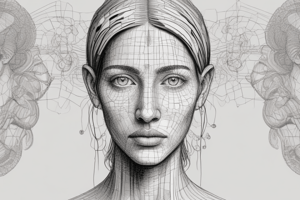Podcast
Questions and Answers
Which of the following best describes emotions?
Which of the following best describes emotions?
- Biological responses that are constant and unchanging.
- Short-term responses to specific challenges and opportunities. (correct)
- Long-term psychological states influenced by external events.
- Emotional reactions that do not involve physiological changes.
What do appraisal theories emphasize regarding emotions?
What do appraisal theories emphasize regarding emotions?
- Emotions are basic feelings inherent to all humans.
- Facial expressions are the primary indicators of emotions.
- Emotions are unlearned responses to physical stimuli.
- Appraisal of objects must occur to elicit an emotion. (correct)
Which of the following is a key feature of emotions?
Which of the following is a key feature of emotions?
- They are always accompanied by behavioral dispositions.
- They remain constant regardless of context.
- They require time to develop before being expressed.
- They have social functions and involve physiological changes. (correct)
According to evolutionary theories, emotions serve which of the following functions?
According to evolutionary theories, emotions serve which of the following functions?
How do social constructionism theories view emotions?
How do social constructionism theories view emotions?
Which is NOT a main emotion described under evolutionary theories?
Which is NOT a main emotion described under evolutionary theories?
What aspect do emotional responses typically involve?
What aspect do emotional responses typically involve?
Which of the following best captures the concept of culture in relation to emotions?
Which of the following best captures the concept of culture in relation to emotions?
What is a characteristic of individuals from collectivistic cultures regarding emotion perception?
What is a characteristic of individuals from collectivistic cultures regarding emotion perception?
What specifies the main difference in affect valuation between East Asians and Westerners according to Affect Valuation Theory?
What specifies the main difference in affect valuation between East Asians and Westerners according to Affect Valuation Theory?
Which statement correctly contrasts the dialectical and optimizing doctrines of emotion?
Which statement correctly contrasts the dialectical and optimizing doctrines of emotion?
What did Matsumoto et al. (2008) suggest about individualistic countries regarding emotions?
What did Matsumoto et al. (2008) suggest about individualistic countries regarding emotions?
How do Japanese participants typically respond in emotional context judgments compared to European Canadians?
How do Japanese participants typically respond in emotional context judgments compared to European Canadians?
What is a commonly expressed feeling among East Asians in relation to positive emotions?
What is a commonly expressed feeling among East Asians in relation to positive emotions?
What tendency is indicated about emotional expressions in the presence of an experimenter among Japanese participants?
What tendency is indicated about emotional expressions in the presence of an experimenter among Japanese participants?
Which of the following characteristics is associated with independence in thinking styles?
Which of the following characteristics is associated with independence in thinking styles?
How do collectivist cultures typically express emotions compared to individualist cultures?
How do collectivist cultures typically express emotions compared to individualist cultures?
Which cultural dimension framework examines the relationship between individualism and collectivism?
Which cultural dimension framework examines the relationship between individualism and collectivism?
What is one challenge noted in cross-cultural psychology regarding emotional measurement?
What is one challenge noted in cross-cultural psychology regarding emotional measurement?
How does the dialectical doctrine of emotion differ from the optimizing doctrine?
How does the dialectical doctrine of emotion differ from the optimizing doctrine?
What is a potential misconception regarding the expression of emotions across cultures?
What is a potential misconception regarding the expression of emotions across cultures?
Which method is NOT commonly used to measure emotions in cross-cultural psychology?
Which method is NOT commonly used to measure emotions in cross-cultural psychology?
What is one of the main difficulties in understanding emotional experiences in diverse cultures?
What is one of the main difficulties in understanding emotional experiences in diverse cultures?
Which statement reflects the Universality Hypothesis regarding emotions?
Which statement reflects the Universality Hypothesis regarding emotions?
What is a key observation regarding facial expressions between American and Japanese individuals when watching stressful movies with an experimenter?
What is a key observation regarding facial expressions between American and Japanese individuals when watching stressful movies with an experimenter?
Which statement best describes the cultural dimensions framework developed by Hofstede?
Which statement best describes the cultural dimensions framework developed by Hofstede?
How do individualistic cultures typically view self-concept compared to collectivistic cultures?
How do individualistic cultures typically view self-concept compared to collectivistic cultures?
What does the dialect theory of facial expressions suggest about cultural variations?
What does the dialect theory of facial expressions suggest about cultural variations?
What factor can influence the perception of emotions in facial expressions according to the group advantage concept?
What factor can influence the perception of emotions in facial expressions according to the group advantage concept?
Which of the following best illustrates the implications of display rules in collectivistic cultures?
Which of the following best illustrates the implications of display rules in collectivistic cultures?
What was a significant finding regarding emotional expressiveness among different regional cultures within the same country?
What was a significant finding regarding emotional expressiveness among different regional cultures within the same country?
How is the experience of emotions characterized differently in collectivistic cultures as opposed to individualistic cultures?
How is the experience of emotions characterized differently in collectivistic cultures as opposed to individualistic cultures?
Flashcards
Emotion: Definition
Emotion: Definition
Brief, biologically based patterns of perception, experience, physiology, action, and communication, responding to challenges and opportunities.
Basic Emotions
Basic Emotions
Anger, fear, disgust, surprise, happiness, and sadness; considered fundamental and universally recognizable.
Evolutionary Theory of Emotion
Evolutionary Theory of Emotion
Emotions aid survival and communication; expressions are continuous between humans and animals.
Appraisal Theory of Emotion
Appraisal Theory of Emotion
Signup and view all the flashcards
Social Constructionism of Emotion
Social Constructionism of Emotion
Signup and view all the flashcards
Emotion Components
Emotion Components
Signup and view all the flashcards
Emotional Appraisal
Emotional Appraisal
Signup and view all the flashcards
Cross-Cultural Emotion
Cross-Cultural Emotion
Signup and view all the flashcards
Japanese Emotion Expression
Japanese Emotion Expression
Signup and view all the flashcards
Individualistic vs. Collectivist Culture
Individualistic vs. Collectivist Culture
Signup and view all the flashcards
Thinking Styles
Thinking Styles
Signup and view all the flashcards
Emotional Context
Emotional Context
Signup and view all the flashcards
Dialectical Emotion Doctrine
Dialectical Emotion Doctrine
Signup and view all the flashcards
Optimising Emotion Doctrine
Optimising Emotion Doctrine
Signup and view all the flashcards
Affect Valuation Theory
Affect Valuation Theory
Signup and view all the flashcards
Emotional Experience Differences
Emotional Experience Differences
Signup and view all the flashcards
In-Group Advantage
In-Group Advantage
Signup and view all the flashcards
Dialect Theory of Facial Expressions
Dialect Theory of Facial Expressions
Signup and view all the flashcards
Cultural Dimensions
Cultural Dimensions
Signup and view all the flashcards
Collectivism vs. Individualism
Collectivism vs. Individualism
Signup and view all the flashcards
Independent vs. Interdependent Self
Independent vs. Interdependent Self
Signup and view all the flashcards
Display Rules
Display Rules
Signup and view all the flashcards
Hofstede's Framework
Hofstede's Framework
Signup and view all the flashcards
Markus and Kitayama's Independent and Interdependent Self
Markus and Kitayama's Independent and Interdependent Self
Signup and view all the flashcards
Culture and Emotion
Culture and Emotion
Signup and view all the flashcards
Cross-Cultural Differences
Cross-Cultural Differences
Signup and view all the flashcards
WEIRD Samples
WEIRD Samples
Signup and view all the flashcards
Cultural Expertise
Cultural Expertise
Signup and view all the flashcards
Universality Hypothesis
Universality Hypothesis
Signup and view all the flashcards
Study Notes
Emotion Learning Objectives
- Concepts of emotions and culture
- Cross-cultural similarities and differences in emotional experience and expression
- Cultural dimensions to investigate cross-cultural differences in emotion
What are Emotions?
- Episodic, short-term, biologically based patterns
- Perception, experience, physiology, and communication
- Occur in response to physical and social challenges & opportunities
Key Features of Emotions
- Brief responses to things, people, events, and thoughts
- Social functions
- Involve: evaluation, physiological changes, expressions, subjective experience, and mental processes/behavioral dispositions
- Tools for evaluating experience and preparing for action
Theories of Emotion
-
Evolutionary Theories:
- Charles Darwin and Paul Ekman
- Emotions are feelings and actions
- Continuity between human and animal expressions
- Emotions have survival and signaling roles ('serviceable habits')
- Emphasis on facial expressions
- Basic emotions: anger, fear, disgust, surprise, happiness, sadness
-
Appraisal Theories:
- Focus on how people appraise an event
- Magda Arnold: object appraised as affecting the individual
-
Constructionist Theories:
- William James: Emotions as awareness of physiological adjustments
- James Averill: Emotions are social constructions, understood socially
Social Constructionism
- William James: Emotion is awareness of physiological adjustments
- Emotions are bodily changes
- Autonomic nervous system, facial, and bodily feedback play key roles
- James Averill: Emotions are social constructions. Can be fully understood only from a social perspective.
- Socially prescribed responses in specific situations.
- Emotions are learned through socialization
- Lisa Feldman Barrett: Emotions are constructed from social and historical knowledge
Culture
- Part of our environment made by humans (Oyserman, 2017)
Functions of Culture
-
Provides predictability, social rules
-
Facilitates life in groups & social coordination
-
Sustains individual welfare
-
Clarifies group boundaries
-
Feels like reality (We need to step outside our culture to recognize it)
-
Levels of Cultures:
- Countries
- Subcultures
- Social class
- Religion
- Skin color
- Professions
- Political preferences
Studying That Suits You
Use AI to generate personalized quizzes and flashcards to suit your learning preferences.





